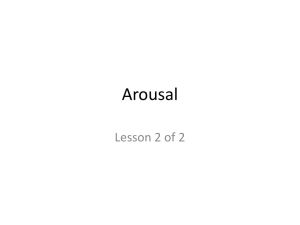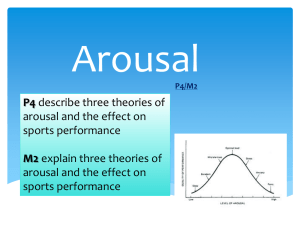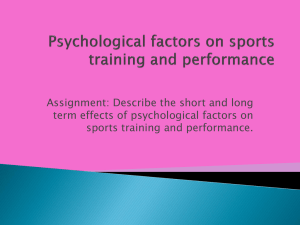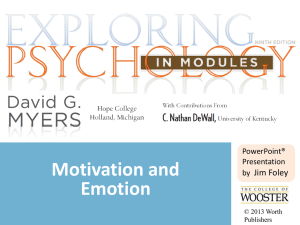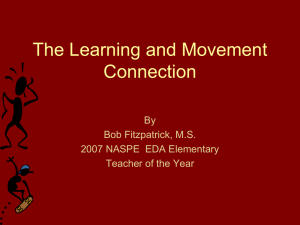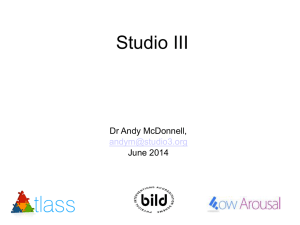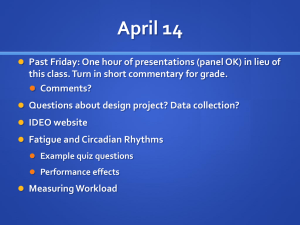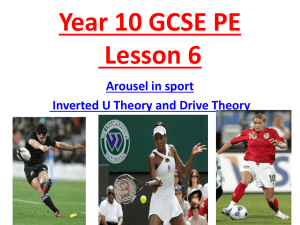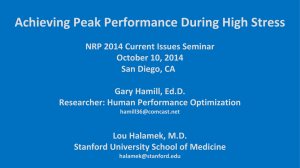File - MrGillPE.com
advertisement
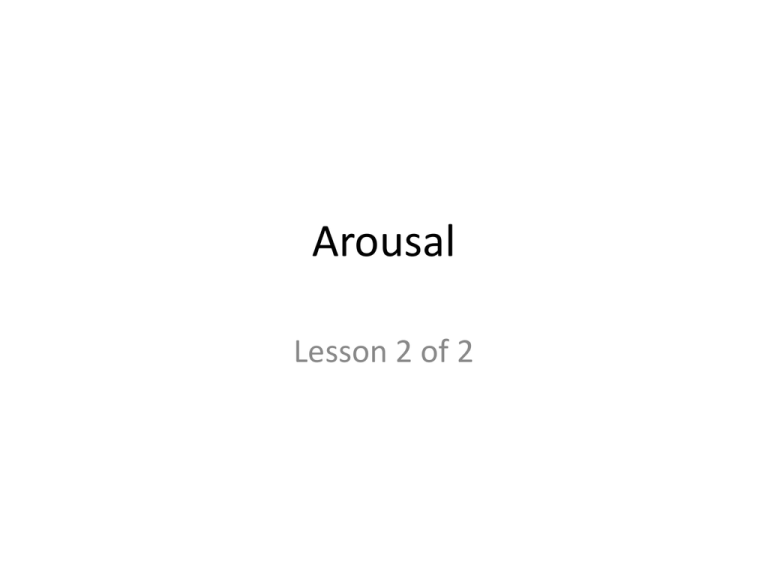
Arousal Lesson 2 of 2 Home learning • Questions on page 139 Connector Name and describe what is shown Connector Group presentation review Drive reduction Inverted U Catastrophe Drive Theory (Hull, 1943) Proposed a linear relationship between arousal and performance • As arousal increases so will quality of performance Higher levels of arousal would intensify the dominant response • For Elite performers this is likely to be correct response • For beginners likely to be incorrect response Spence and Spence (1968) adapted it using an equation:• Performance = Habit strength x drive Now considered an inadequate explanation When arousal reaches a high enough point performance will not improve Ronaldo DRIVE THEORY Performance = Habit strength X Drive P=HD The more an elite sports person is aroused the better their performance due to the dominant response being chosen is habitual. The more a beginner sports person is aroused the dominant response may be incorrect and high levels of arousal can cause a deterioration in performance. PROBLEMS WITH DRIVE THEORY • The habitual behaviour/ dominant response is not always the correct one (think of beginners) • By increasing drive (arousal) performers often resort to previously learned skills because they are dominant but may be incorrect. • Even highly skilled players ‘choke’ in highly charged situations. • Anything else? Does not consider somatic and cognitive Inverted U Hypothesis (Yerkes and Doson, 1908) Suggests that performance will increase with arousal to an optimum point. • However if you go beyond that point then performance will decrease From observations this seems to fit very well, however, it is too simplistic • Does it apply equally to the different phases of learning? • Does it apply to all sports performance in the same way? PROBLEMS WITH INVERTED U THEORY • Critics question if optimal arousal always occurs at the midpoint of the curve. • One curve does not explain the different optimal levels of arousal needed for simple and complex tasks. Anything else? Does it apply equally to the different phases of learning? Beginners find it more difficult to cope with arousal – Less habitual (Similar to Drive theory) – Need to give more attention to the skill itself and arousal levels make take concentration away – Rely heavily on environmental cues, may miss what is unexpected Autonomous Associative Cognitive Performance • Arousal Does it apply to all sports performance in the same way? Can vary according to the skill being performed • Gross skills benefit from higher levels of arousal then fine skills – Shot Putt compared to Archery Can vary within a sport dependant upon role – Rugby forwards compared to backs Lion's team talk Gross/ Simple Fine/ Complex Performance • Arousal AROUSAL THEORIES (3) CATASTROPHE THEORY A theory that predicts a rapid decline in performance resulting from the combination of high cognitive anxiety and increasing somatic anxiety. Devised by Hardy and Frazey (1987) Is a development of the Inverted U theory but involves a faster and more dramatic reduction in performance. It is more a model than theory because it tries to predict human behaviour rather than explain it. How does it differ from inverted U? CATASTROPHE THEORY Point A Cognitive anxiety is high. Somatic anxiety is low. Performance is enhanced. Point B Cognitive anxiety is high. Somatic anxiety is high. Performance can deteriorate. Point D Performance does not return to original level immediately even though performer is trying to decrease arousal. Point C Performance still deteriorating. The worst over ever? CATASTROPHE THEORY Physiological arousal is related to performance in an inverted ‘U’ fashion when the athlete is not worried or has low cognitive anxiety state anxiety. If cognitive anxiety is high, the increases in arousal pass a point of optimal arousal and a rapid decline in performance occurs (the catastrophe). It would be very difficult to recover from this point. AROUSAL AND ITS IMPACT ON PERFORMANCE Once we attain our optimum level our reactions are at their fastest, we are able to screen out irrelevant information and do NOT suffer from Attentional Narrowing and Attentional Wastage Attentional Narrowing: Focusing on too narrow a range of information or on the performance of a skill; this causes the performer to ignore important cues or information. This occurs when a performer is so tightly focused on performing the skill, or on a small part of the display (e.g. the defender in front of them), that they do not attend to other important aspects or they miss important cues (e.g. team mates they could pass to). Outcomes • Critique the ZOF and explain what is required to enter ‘being in the zone’ • Compare the ZOF with the inverted U theory • Critique Peak Flow Experience taking into consideration the factors that may interfere with the experience Provide a sporting example for A and B ZOF – Consider the type of skill Read the articles on Page 137 • Share your thoughts Prove it review Do you understand the following? • drive, inverted U and catastrophe theories • practical applications and impact on performance • Zone of Optimal Functioning and peak flow experience
